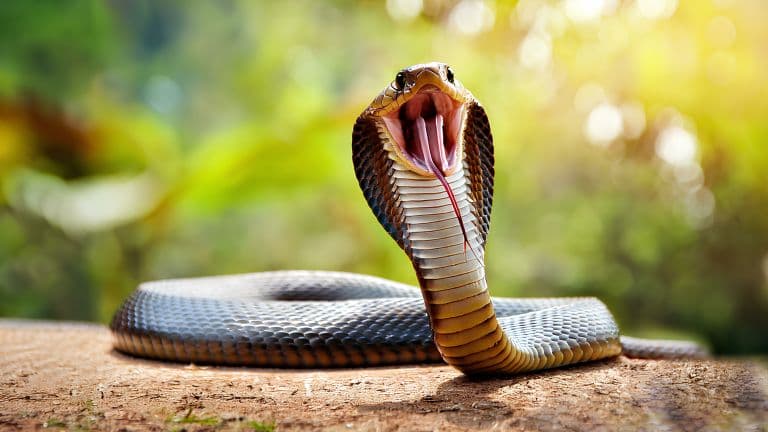From venomous frogs to poisonous snakes, the animal world is full of dangerous and frustratingly contrarian ways to kill you. Yet, it’s easy to mix up the terms venom and poison.
They may both be toxins, but their routes of administration set them distinctly apart.
So, what really is the difference between venom and poison? Let’s take a closer look.

The TL;DR
The difference between venom and poison is how the toxin is delivered.
A Venom is a toxin that an organism delivers into another organism through a specialized structure such as fangs, stingers, or spines. This could be a rattlesnake bite or a scorpion sting.
In contrast, poison is a toxin that typically acts when it’s ingested, inhaled, or absorbed through the skin.
In short, as the saying goes: “If it bites you and you get sick, it’s venom. If you bite it and you get sick, it’s poison”.
But there’s more to it to be explored, so read on for the details!
The Difference Between Venom and Poison
Both venom and poison are toxins, but the distinction between the two lies in how the toxin is delivered.
Venom, while technically a poison, requires an extra active injection mechanism to work, so organisms that use venom tend to have hollow fangs, stingers, spines, hairs or pincers.
Poison, on the other hand, is more commonly a passive and unspecialised defence; the toxin is part of the creature’s makeup (skin, flesh, etc.) or a substance it excretes.
Let’s explore each concept in more depth to see what sets them apart.
What Is Venom?
Venom is a toxic substance (also known as poison!) mostly used as a predatory or defensive aid.
Venomous organisms often make use of specialized glands for producing the toxin, along with an injection system to deliver it effectively. Here are a few examples:
- Venomous Snakes, like cobras and vipers, inject venom through hollow fangs in their mouths.
- Stinging nettles have special glass hairs that hold acid, which are designed to break off in your legs and put a dampener on your nice summer walk.
- Jellyfish use hypodermic stinging cells that explode into your legs and put a dampener on your nice summer swim.
Venoms can be as simple as the formic acid in nettles or the intricate and complex concoction of proteins found in the venom of a snake.
They can be for causing pain, paralysis, or even – in another example of the Brazilian wandering spider – a very persistent erection.
The important point to note here is that, much like an erection, venoms have to be administered into a receiver using a special organ to do the job they were intended to do.
What Is Poison?
Poison is a toxic substance mostly used in nature as a predatory or defensive aid.
It’s harmful through contact, inhalation, or ingestion, and doesn’t necessarily come from an organism – chlorine, drain cleaner, or even some air fresheners can be classified as poisonous in that they will likely make you very sick if they get into you.
So, poison comes in many forms. Some examples from nature include:
- Poison dart frogs secrete very potent toxins through their skin that make them unpleasant to eat.
- Plants like poison ivy or nightshades contain chemicals that are harmful if eaten or even touched in some cases.
- Many mushrooms have very dangerous poisons, like Amanita phalloides which causes 90% of mushroom poisoning fatalities worldwide; and others have a healthy balance of poison and useful mind-expanding compounds, like its close relative Amanita muscaria, responsible for 90% of the non-psilocybe spiritual enlightenment events among Vikings.
In these cases, the toxins protect organisms by discouraging other creatures from making a meal of them.
Summary
Venom is a poison, and poison is also poison, so things can get a bit confusing. But poison becomes a venom when it’s actively injected into a victim.
Most harmful snakes are venomous, but the tiger keelback is so packed full of toxins that it has both venom and poison.
Likewise, most dangerous frogs are poisonous, but the Greening’s frog from Brazil has special spines on its head that it uses to inject its poisonous skin secretions into an enemy, making it both poisonous and venomous.
In general, poisons are defensive or entirely passive toxins. They need to be inhaled, rubbed up against or eaten to cause harm. If those toxins are placed in a hollow fang, spine, hair or pincer and injected into something, they are now considered venoms.
This is why, though we cannot advise it for legal reasons, it’s perfectly safe to drink snake venom as long as there are no ulcers in your mouth from all the poisonous toads you’ve been licking.